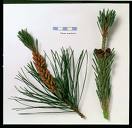Bishops Pine Tree Information
Images of Bishops Pine:






Bishops Pine grows in the following 3 states and provinces:
California, Colorado, MaineInformation about Bishops Pine:
The Pinus Muricata is commonly known as the Bishop Pine, Bishop's Pine, California Swamp Pine as well as Prickle-cone Pine.
The currently accepted scientific name of bishop pine is Pinus muricata D. Don . Recognized varieties are : Pinus muricata var. borealis (Howell) Axelrod Pinus muricata var. stantonii Axelrod Pinus muricata var. muricata Bishop pine rarely hybridizes with Monterey pine (P. radiata); timing of cone opening usually differs in the two species .Bishop pine occurs in disjunct populations in coastal California from Humboldt County south to Santa Barbara County. It is also found on Santa Cruz and Santa Rosa islands, and in Baja California, Mexico .Bishop pine is frequently dominant in closed-cone pine forests . Stands are open with little or no understory on dry, rocky sites, with a more dense understory on moist sites . Bishop pine also occurs in mesic border areas of woodlands and savannas . In the northern part of its range, bishop pine occurs in pure stands and in redwood (Sequoia sempervirens), Douglas-fir (Pseudotsuga menziesii), and pygmy forests . In the southern portion of its range, it is found in annual grassland, coastal sage scrub, and chaparral communities. Scattered bisop pine stands often form a mosaic with these communities . Bishop pine is named as a dominant tree in the following published classifications: Terrestrial natural communities of California A vegetation classification system applied to southern California The southern California islands Vascular plant communities of California The closed-cone pines and cypress Associated canopy species not previosly mentioned include Gowen cypress (Cupressus goveniana ), Monterey cypress (C. macrocarpa), Tecate cypress (C. guadalupensis var. forbesii), Mendocino cypress (C. goveniana var. pigmaea), Bolander pine (Pinus contorta var. bolanderi), Monterey pine (Pinus radiata), and Pacific madrone (Arbutus menziesii) . Understory associates include glossyleaf manzanita (Arctostaphylos nummularia), woollyleaf manzanita (Arctostaphylos tomentosa), Pacific rhododendron (Rhododendron macrophyllum), California huckleberry (Vaccinium ovatum), and salal (Gautheria shallon) .Some of the information provided here is attributed to:Cope, Amy B. 1993. Pinus muricata. In: Fire Effects Information System, [Online]. U.S. Department of Agriculture, Forest Service, Rocky Mountain Research Station, Fire Sciences Laboratory (Producer). , available at the USDA Fire Effects Information System (FEIS) website